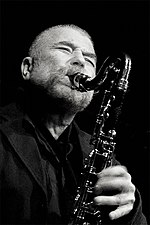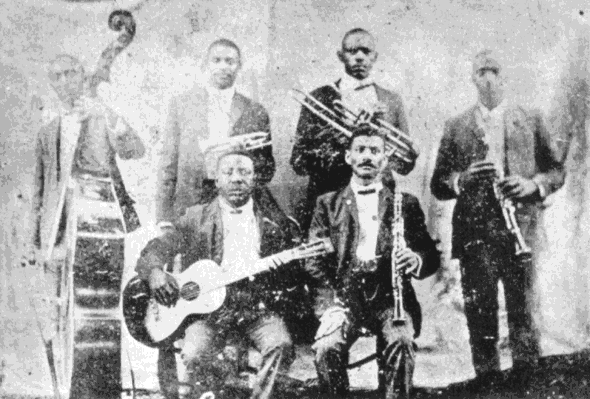Dixieland revival
In the late 1930s there was a revival of "Dixieland" music, harkening back to the original contrapuntal New Orleans style. This was driven in large part by record company reissues of early jazz classics by the Oliver, Morton, and Armstrong bands of the 1930s. There were two populations of musicians involved in the revival. One group consisted of players who had begun their careers playing in the traditional style, and were either returning to it, or continuing what they had been playing all along, such as Bob Crosby's Bobcats, Max Kaminsky, Eddie Condon, and Wild Bill Davison. Most of this group were originally Midwesterners, although there were a small number of New Orleans musicians involved as well. The second population of revivalists consisted of young musicians such as the Lu Watters band. By the late 1940s, Louis Armstrong's Allstars band became a leading ensemble. Through the 1950s and 1960s, Dixieland was one of the most commercially popular jazz styles in the US, Europe, and Japan, although critics paid little attention to it.[39]
Bebop

In the early 1940s bebop performers helped to shift jazz from danceable popular music towards a more challenging "musician's music." Differing greatly from swing, early bebop divorced itself from dance music, establishing itself more as an art form but lessening its potential popular and commercial value. Since bebop was meant to be listened to, not danced to, it used faster tempos. Beboppers introduced new forms of chromaticism and dissonance into jazz; the dissonant tritone (or "flatted fifth") interval became the "most important interval of bebop"[40] and players engaged in a more abstracted form of chord-based improvisation which used "passing" chords, substitute chords, and altered chords. The style of drumming shifted as well to a more elusive and explosive style, in which the ride cymbal was used to keep time, while the snare and bass drum were used for unpredictable, explosive accents.
These divergences from the jazz mainstream of the time initially met with a divided, sometimes hostile response among fans and fellow musicians, especially established swing players, who bristled at the new harmonic sounds. To hostile critics, bebop seemed to be filled with "racing, nervous phrases"[41]Despite the initial friction, by the 1950s bebop had become an accepted part of the jazz vocabulary. The most influential bebop musicians included saxophonist Charlie Parker, pianists Bud Powell and Thelonious Monk, trumpeters Dizzy Gillespie and Clifford Brown, tenor sax player Lester Young, and drummer Max Roach. (See also List of bebop musicians).
Cool jazz
By the end of the 1940s, the nervous energy and tension of bebop was replaced with a tendency towards calm and smoothness, with the sounds of cool jazz, which favoured long, linear melodic lines. It emerged in New York City, as a result of the mixture of the styles of predominantly white jazz musicians and black bebop musicians, and it dominated jazz in the first half of the 1950s. Cool jazz recordings by Chet Baker, Dave Brubeck, Bill Evans, Gil Evans, Stan Getz and the Modern Jazz Quartet usually have a "lighter" sound which avoided the aggressive tempos and harmonic abstraction of bebop. An important recording was trumpeter Miles Davis's Birth of the Cool (tracks originally recorded in 1949 and 1950 and collected as an LP in 1957). Cool jazz styles had a particular resonance in Europe, especially Scandinavia, with emergence of such major figures as baritone saxophonist Lars Gullin and pianist Bengt Hallberg. Players such as pianist Bill Evans later began searching for new ways to structure their improvisations by exploring modal music. The theoretical underpinnings of cool jazz were set out by the blind Chicago pianist Lennie Tristano. Cool jazz later became strongly identified with the West Coast jazz scene. Its influence stretches into such later developments as Bossa nova, modal jazz (especially in the form of Davis's Kind of Blue 1959), and even free jazz (see also the List of Cool jazz and West Coast jazz musicians).
Hard bop
Hard bop is an extension of bebop (or "bop") music that incorporates influences from rhythm and blues, gospel music, and blues, especially in the saxophone and piano playing. Hard bop was developed in the mid-1950s, partly in response to the vogue for cool jazz in the early 1950s. The hard bop style coalesced in 1953 and 1954, paralleling the rise of rhythm and blues. Miles Davis' performance of "Walkin'" the title track of his album of the same year, at the very first Newport Jazz Festival in 1954, announced the style to the jazz world. The quintet Art Blakey and the Jazz Messengers, fronted by Blakey and featuring pianist Horace Silver and trumpeter Clifford Brown, were leaders in the hard bop movement along with Davis. (See also List of Hard bop musicians)
Modal jazz
Modal jazz is a development beginning in the later 1950s which takes the mode, or musical scale, as the basis of musical structure and improvisation. Previously, the goal of the soloist was to play a solo that fit into a given chord progression. However, with modal jazz, the soloist creates a melody using one or a small number of modes. The emphasis in this approach shifts from harmony to melody. Miles Davis recorded one of the best selling jazz albums of all time in the modal framework: Kind of Blue, an exploration of the possibilities of modal jazz. Other innovators in this style include John Coltrane and Herbie Hancock.
Free jazz

Free jazz and the related form of avant-garde jazz broke through into an open space of "free tonality" in which meter, beat, and formal symmetry all disappeared, and a range of World music from India, Africa, and Arabia were melded into an intense, even religiously ecstatic or orgiastic style of playing[42]. While rooted in bebop, free jazz tunes gave players much more latitude; the loose harmony and tempo was deemed controversial when this approach was first developed. The bassist Charles Mingus is also frequently associated with the avant-garde in jazz, although his compositions draw from a myriad of styles and genres. The first major stirrings came in the 1950s, with the early work of Ornette Coleman and Cecil Taylor. In the 1960s, performers included John Coltrane (A Love Supreme), Archie Shepp, Sun Ra, Albert Ayler, Pharoah Sanders, and others. Free jazz quickly found a foothold in Europe – in part because musicians such as Ayler, Taylor, Steve Lacy and Eric Dolphy spent extended periods in Europe. A distinctive European contemporary jazz (often incorporating elements of free jazz but not limited to it) flourished also because of the emergence of musicians (such as John Surman, Zbigniew Namyslowski, Albert Mangelsdorff, Kenny Wheeler and Mike Westbrook) anxious to develop new approaches reflecting their national and regional musical cultures and contexts. Keith Jarrett has been prominent in defending free jazz from criticism by traditionalists in the 1990s and 2000s.
3:33 AM | | 0 Comments
1890s–1910s
Ragtime
- Main article: Ragtime

The abolition of slavery led to new opportunities for education of freed African-Americans, but strict segregation meant limited employment opportunities. Black musicians provided "low-class" entertainment at dances, in minstrel shows, and in vaudeville, and many marching bands formed. Black pianists played in bars, clubs and brothels, and ragtime developed.[13][14]
Ragtime appeared as sheet music with the African American entertainer Ernest Hogan's hit songs in 1895, and two years later Vess Ossman recorded a medley of these songs as a banjo solo "Rag Time Medley".[15][16] Also in 1897, the white composer William H. Krell published his "Mississippi Rag" as the first written piano instrumental ragtime piece. The classically-trained pianist Scott Joplin produced his "Original Rags" in the following year, then in 1899 had an international hit with "Maple Leaf Rag." He wrote numerous popular rags, including, "The Entertainer", combining syncopation, banjo figurations and sometimes call-and-response, which led to the ragtime idiom being taken up by classical composers including Claude Debussy and Igor Stravinsky. Blues music was published and popularized by W. C. Handy, whose "Memphis Blues" of 1912 and "St. Louis Blues" of 1914 both became jazz standards.[12]
New Orleans music

The music of New Orleans had a profound effect on the creation of early jazz. Many early jazz performers played in the brothels and bars of red-light district around Basin Street called "Storyville."[17] In addition, numerous marching bands played at lavish funerals arranged by the African American community. The instruments used in marching bands and dance bands became the basic instruments of jazz: brass and reeds tuned in the European 12-tone scale and drums. Small bands of primarily self-taught African American musicians, many of whom came from the funeral-procession tradition of New Orleans, played a seminal role in the development and dissemination of early jazz, traveling throughout Black communities in the Deep South and, from around 1914 on, Afro-Creole and African American musicians playing in vaudeville shows took jazz to western and northern US cities.[18]

Afro-Creole pianist Jelly Roll Morton began his career in Storyville. From 1904, he toured with vaudeville shows around southern cities, also playing in Chicago and New York. His "Jelly Roll Blues," which he composed around 1905, was published in 1915 as the first jazz arrangement in print, introducing more musicians to the New Orleans style.[19] In the northeastern United States, a "hot" style of playing ragtime had developed, notably James Reese Europe's symphonic Clef Club orchestra in New York which played a benefit concert at Carnegie Hall in 1912. [20][21] The Baltimore rag style of Eubie Blake influenced James P. Johnson's development of "Stride" piano playing, in which the right hand plays the melody, while the left hand provides the rhythm and bassline.[22]
The Original Dixieland Jass Band made the first Jazz recordings early in 1917, their "Livery Stable Blues" became the earliest Jazz recording. [23] [24] [25] [26] [27] [28] [29] That year numerous other bands made recordings featuring "jazz" in the title or band name, mostly ragtime or novelty records rather than jazz. In September 1917 W.C. Handy's Orchestra of Memphis recorded a cover version of "Livery Stable Blues".[30] In February 1918 James Reese Europe's "Hellfighters" infantry band took ragtime to Europe during World War I,[31] then on return recorded Dixieland standards including "The Darktown Strutter's Ball".[21]
3:32 AM | | 0 Comments